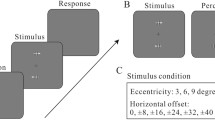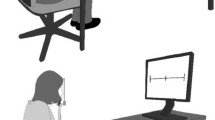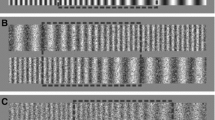Abstract
A subset of right brain-damaged patients shows leftward overextension in the line extension task. It has been argued that this deficit can be attributed to a distortion of the metric structure of perceived space (spatial anisometry). We investigated whether spatial distortion of static stimuli is associated with a corresponding misperception of perceived acceleration of moving stimuli. Seven right brain-damaged patients with spatial anisometry and two control groups were presented with stimuli moving leftwards or rightwards along the horizontal axis at different rates of acceleration. They were asked to estimate whether the target accelerated or decelerated. The anisometric group judged the perceived acceleration of leftward motions as less than that of rightward motions. The magnitude of the misperception of acceleration correlated positively with relative left overextension in the line extension task and with rightward displacement error in the line bisection task. This directional difference is in line with the predictions of the spatial anisometry hypothesis.



Similar content being viewed by others
Notes
Patients 3 and 13 of the present study correspond to patients FZ and RE of our previous work (Geminiani et al. 2004).
References
Barton JJ, Sharpe JA, Raymond JE (1996) Directional defects in pursuit and motion perception in humans with unilateral cerebral lesions. Brain 119:1535–1550
Battelli L, Cavanagh P, Intriligator J, Tramo MJ, Henaff MA, Michel F, Barton J (2001) Right parietal lesion leads to bilateral deficit for high-level motion. Neuron 32:985–995
Bisiach E, Pizzamiglio L, Nico D, Antonucci G (1996) Beyond unilateral neglect. Brain 119:851–857
Bisiach E, Ricci R, Neppi Modona M (1998) Visual awareness and anisometry of space representation in unilateral neglect: a panoramic investigation by means of a line extension task. Conscious Cogn 7:327–355
Calderone JB, Kaiser MK (1989) Visual acceleration detection: effect of sign and motion orientation. Percept Psychophys 45:391–394
Cartwright D (1938) On visual speed. Psychol Forsch 22:320–342
Culham J, He S, Dukelow S, Verstaten FAJ (2001) Visual motion and the human brain: what neuroimaging told us? Acta Psychol 107:69–94
Damasio H, Damasio AR (1989) Lesion analysis in neuropsychology. Oxford University Press, New York
Diller L, Weinber J (1977) Hemi-inattention in rehabilitation. The evolution of a rational remediation program. In: Weinstein EA, Friedland RP (eds) Hemi-inattention and hemisphere specialization. Raven, New York, pp 62–82
Doricchi F, Angelelli P (1999) Misrepresentation of horizontal space in left unilateral neglect: role of hemianopia. Neurology 52:1845–1852
Dunai J, Bennet K, Fotiades A, Kritikos A, Castiello U (1999) Modulation of unilateral neglect as a function of direction of object motion. Neuroreport 10:1041–1047
Geminiani G, Camaschella E, Mariani C, Alberoni M, Farina E (2002) Direction and position factors in performance of line extension task by unilateral neglect subjects. Neuropsychologia 40:1834–1840
Geminiani G, Latini Corazzini L, Stucchi N, Gindri P (2004) Acceleration perception and spatial distortion in a left unilateral neglect patient. Cortex 40:315–322
Howes D, Boller F (1975). Simple reaction time: evidence for focal impairment from lesions of the right hemisphere. Brain 98:317–332
Irving-Bell L, Small M, Cowey A (1999) A distortion of perceived space in patients with right-hemisphere lesions and visual hemineglect. Neuropsychologia 37:919–925
Ishiai S, Sugishita M, Watabiki S, Nakayama T, Kotera M, Gono S (1994) Improvement of left unilateral spatial neglect in a line extension task. Neurology 44:294–298
Karnath HO, Ferber S (1999) Is space representation distorted in neglect? Neuropsychologia 37:7–15
Kerkhoff G, Schindler I, Keller I, Marquadt C (1999) Visual background motion reduces size distortion in spatial neglect. Neuroreport 10:319–323
Marshall JC, Halligan PW (1993) Visuo-spatial neglect: a new coping test to assess perceptual parsing. J Neurol 240:37–40
Mattingley JB, Bradshaw JL, Bradshaw JA (1994) Horizontal visual motion modulates focal attention in left unilateral spatial neglect. J Neurol Neurosurg Psychiatry 57:1228–1235
Milner AD, Harvey M (1995) Distortion of size perception in visuospatial neglect. Curr Biol 5:85–89
Milner AD, Harvey M, Roberts RC, Forster SV (1993) Line bisection errors in visual neglect: misguided action or size distortion? Neuropsychologia 31:39–49
Milner AD, Harvey M, Pritchard CL (1998) Visual size processing in spatial neglect. Exp Brain Res 123:192–200
Rock I (1968) The basis of position-constancy during passive movement. Am J Psychol 81:262–265
Rorden C, Mattingley JB, Karnath HO, Driver J (1997) Visual extinction and prior entry: impaired perception of temporal order with intact motion perception after unilateral parietal damage. Neuropsychologia 35:421–433
Schenk T, Zihl J (1997) Visual motion perception after brain damage. I. Deficits in global motion perception. Neuropsychologia 35:1289–1297
Schenkenberg T, Bradford DC, Ajax ET (1980) Line bisection and unilateral visual neglect in patients with neurological impairments. Neurology 30:509–517
Schmerler J (1976) The visual perception of accelerated motion. Perception 5:167–185
Spinelli D, Zoccolotti P (1992) Perception of moving and stationary gratings in brain damaged patients with unilateral spatial neglect. Neuropsychologia 30:393–401
Stevens JP (1990) Intermediate statistics: a modern approach. Erlbaum, Hillsdale, NJ
Turano KA, Heidenreich SM (1999) Eye movements affect the perceived speed of visual motion. Vision Res 39:1177–1187
Vaina LM, Cowey A, Eskew RT Jr, LeMay M, Kemper T (2001) Regional cerebral correlates of global motion perception. Brain 124:310–321
Werkhoven P, Snippe HP, Toet A (1992) Visual processing of optic acceleration. Vision Res 32:2313–2329
Whitney D (2002) The influence of visual motion on perceived position. Trends Cogn Sci 6:211–216
Acknowledgements
We thank Edoardo Bisiach, Beppe Vallar and three anonymous referees for helpful comments and suggestions, Sergio Duca for assistance with the lesion site analysis, and Stephan Cooper for help with the English. This study was supported by a grant from the Italian Ministry of Universities and Research to G.G.
Author information
Authors and Affiliations
Corresponding author
Rights and permissions
About this article
Cite this article
Latini Corazzini, L., Geminiani, G., Stucchi, N. et al. Visual acceleration and spatial distortion in right brain-damaged patients. Exp Brain Res 161, 276–284 (2005). https://doi.org/10.1007/s00221-004-2068-x
Received:
Accepted:
Published:
Issue Date:
DOI: https://doi.org/10.1007/s00221-004-2068-x




